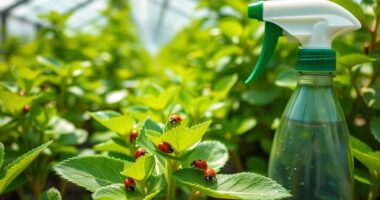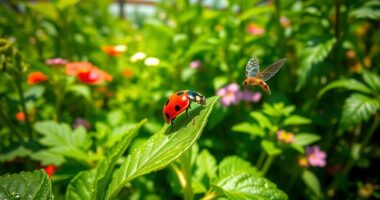To control common greenhouse pests like aphids, whiteflies, and spider mites, regularly inspect your plants for signs such as discolored spots or webbing. Use beneficial insects like ladybugs and predatory mites to naturally keep pest populations in check, and consider organic options like neem oil or insecticidal soaps for quick relief. Combining these methods with good sanitation and monitoring helps prevent severe infestations. Keep exploring to discover more effective strategies for a healthy greenhouse.
Key Takeaways
- Regularly inspect plants for pests like aphids, whiteflies, and spider mites to enable early detection and control.
- Use beneficial insects such as ladybugs and predatory mites to naturally reduce pest populations.
- Apply organic pesticides like neem oil and insecticidal soaps following instructions for safe, effective control.
- Maintain good greenhouse hygiene by removing debris, ensuring proper airflow, and avoiding over-fertilization to prevent pests.
- Integrate biological, organic, and cultural methods for sustainable, long-term pest management.

Greenhouse pests can quickly become a major problem if you don’t stay vigilant. These tiny invaders can damage your plants, reduce yields, and undermine your hard work. Luckily, you have effective tools at your disposal, including beneficial insects and organic pesticides, to keep pests under control without resorting to harsh chemicals. Recognizing pests early is key to managing them effectively. Keep a close eye on your plants, inspecting leaves, stems, and soil regularly. Look for signs like discolored spots, holes in leaves, sticky residues, or webbing, which can indicate pest activity. Once you identify the problem, you can choose a targeted approach to control it.
One of the safest and most environmentally friendly methods involves introducing beneficial insects into your greenhouse. Predatory insects such as ladybugs, predatory mites, and lacewing larvae are natural enemies of common pests like aphids, whiteflies, and spider mites. These beneficial insects work silently to reduce pest populations without harming your plants or creating chemical resistance issues. Releasing beneficial insects is particularly effective when pest populations are just starting to grow, preventing infestations from spiraling out of control. Plus, they’re easy to acquire from garden suppliers or biological control companies, making them a convenient part of your integrated pest management system.
In addition to beneficial insects, organic pesticides can be a useful option when pests become more stubborn. Organic options like neem oil, insecticidal soaps, and pyrethrin-based sprays are derived from natural sources and are generally safe for your plants, beneficial insects, and you. When applying organic pesticides, follow the instructions carefully to avoid harming beneficial insects or causing phytotoxicity. Timing is crucial; applying early in the morning or late in the evening when beneficial insects are less active helps protect them from accidental exposure. Organic pesticides often act quickly to suppress pest populations, giving you a vital edge in maintaining a healthy greenhouse environment.
Combining beneficial insects and organic pesticides provides a balanced, sustainable approach to pest control. Preventative measures like maintaining proper air circulation, removing plant debris, and avoiding over-fertilization also help keep pests at bay. Regular monitoring and understanding divorce statistics can help you anticipate and prevent infestations before they become severe. Remember, the goal isn’t just to eliminate pests but to create a resilient ecosystem where pests are naturally kept in check. By staying vigilant and using these eco-friendly methods, you’ll maintain a thriving greenhouse with healthy plants, minimized chemical use, and a more sustainable gardening practice overall.
Frequently Asked Questions
How Do I Identify Early Signs of Pest Infestation?
To identify early signs of pest infestation, pay close attention to pest damage signs like chewed leaves, discoloration, or sticky residue. Look for early infestation indicators such as tiny webs, eggs, or moving insects on plant surfaces. Regularly inspect your plants, especially undersides of leaves and new growth, so you catch problems early before they spread. Prompt detection helps you take swift action to protect your greenhouse.
Are Organic Methods Effective for Pest Control?
Imagine a gentle garden dance, where nature’s helpers keep pests at bay. Organic methods like compost teas and beneficial fungi are quite effective, giving your plants a natural boost without harsh chemicals. These methods nurture healthy soil and plants, creating an environment that discourages pests. With patience and consistency, you’ll see your greenhouse thrive, protected by nature’s own defenses, making pest control both safe and sustainable.
Can Pests Develop Resistance to Control Measures?
Pests can develop resistance to control measures over time, making management more challenging. You might notice pest resistance when pests survive treatments that previously worked. To prevent this, you should regularly adapt your control strategies, combining different methods like biological controls, organic treatments, and mechanical removal. This control measure adaptation helps reduce the risk of pests developing resistance, ensuring your pest management remains effective and sustainable.
What Are the Best Natural Predators for Greenhouse Pests?
You should consider beneficial insects as your natural predators for biological control in your greenhouse. Ladybugs, predatory mites, and parasitic wasps effectively target pests like aphids, spider mites, and whiteflies. Introducing these beneficial insects helps you reduce chemical use and keeps pests in check naturally. By supporting these biological control agents, you create a healthier, more sustainable environment that minimizes pest damage and promotes healthy plant growth.
How Frequently Should I Inspect My Greenhouse for Pests?
Think of your greenhouse as a delicate dance floor, where pest prevention keeps the rhythm steady. You should inspect your greenhouse at least once a week, like a vigilant sentinel watching for trouble. Regular inspections create a proactive inspection schedule, catching pests early before they spread their wings. By staying attentive and consistent, you keep your plants healthy, and your greenhouse a thriving, pest-free sanctuary.
Conclusion
So, now that you’re a certified pest detective, go ahead—wage war on those tiny invaders. Spray, pick, or introduce their worst nightmare, and watch your plants thrive. After all, who needs a lush greenhouse when pests are throwing the party? With these tips, you’ll have your green paradise pest-free in no time—because nothing says “beautiful garden” like a pest-free zone, right? Happy gardening—may your pests be few and your plants plentiful!







